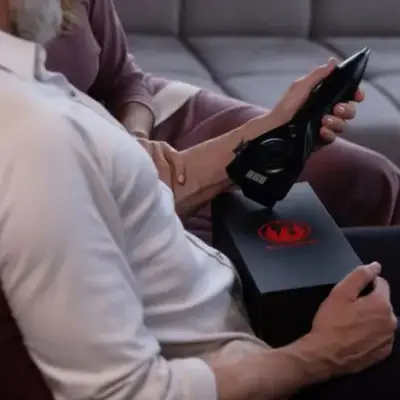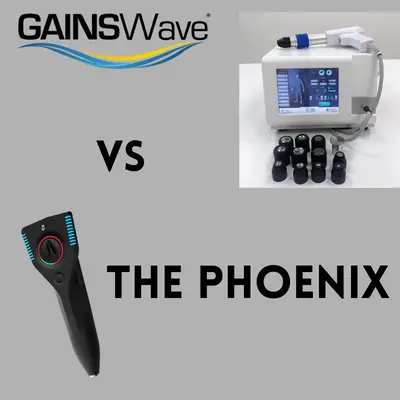Nearly one in four adults will experience knee pain at some point in their lives. Surprisingly, it seems like this number is on the rise. As more people clamor for effective, pain-relieving solutions, engineers and designers struggle to create a product that meets these demands. Transcutaneous electrical nerve stimulation (TENS) devices may be a viable option, but how effective are they?
A TENS unit can help to temporarily relieve knee pain in most individuals by emitting strong electrical signals that counteract pain signals. Those who wish to manage their knee pain without medications could potentially benefit from using a TENS unit, though results vary from person to person.
This article will explore what TENS units and identify what they are, how they work, and whether they can alleviate pain. We’ll also examine how capable a TENS unit may be in relieving knee pain. This way, you can create an informed and educated decision about whether a TENS unit may be right for you.
What Is a TENS Unit?
A TENS unit is typically a small, handheld electronic device comprised of two distinct components:
- A control unit
- Electrode pads
While these components might vary depending on the exact make and model of the device (especially if it is a wireless unit), they’re generally consistent, making them a great place to start when attempting to understand what a TENS unit is and what it can do.
The Control Unit
The control unit is essentially the brain of the unit. It typically features a display screen, inlaid selection buttons, and at least one adapter port. On touchscreen models, the buttons may be absent, but the other two vital features should remain.
The TENS control unit is what emits electrical signals to the electrode pads. It is also what users access to choose therapy settings, intensity levels, and timer options. It accepts the lead cable adapters and continues to provide power to the attached adhesive pads. Without the control unit, the other components would be virtually useless.
Equally, the control unit contains every pre-programmed mode or type of therapy, making it both the heart and brain of a TENS unit. Still, it’s the electrode pads and lead cables, the arms, and legs of a TENS unit, that do most of the hands-on work.
The Electrode Pads
The electrode pads are typically cloth-like pads that adhere to the skin. They have a connector port that allows the lead cable to either snap-on or plug into the pad. That lead cable then connects into the control unit, which powers the electrode pads.
In wireless TENS units, the pads often require some type of receiver or adapter to function, because there are no lead cables to form a consistent connection and charge.
How Does a TENS Unit Work?
No matter what type of TENS unit you’re working with, it’s bound to work in essentially the same way. Of course, wireless units function slightly differently, but they still follow this general progression:
- Attach the electrode pads.
- Connect the lead cables.
- Plug the cable adapters into the control unit.
- Turn the control unit on
- Use the buttons or touchscreen to adjust your desired settings.
- The TENS unit will begin to send out waves of electrical impulses.
If you’re not familiar with these components, or TENS units in general, this setup list might seem like gibberish. Let’s break things down and briefly explore the details of the TENS unit operation.
Attach
The very first thing that you’ll need to do is locate your electrode pads. Each one should have a thin film of protective plastic on the bottom side. Once you’ve got them handy, go ahead and clean your desired treatment area with mild soap and clean water. Pat dry.
Be sure the area is clean and dry, then go ahead and peel the plastic off. Don’t throw this tiny covering away. You can reuse and reapply these plastic bits to extend the life of your electrode pads. Once you have a sticky pad ready, apply it above, below, or beside the painful area.
You may only worsen your pain if you attach an electrode pad directly to a sore muscle or painful nerve. When hoping to use a TENS unit for knee pain, it’s vital to never place a pad directly on the kneecap. Instead, use a plus or cross-like configuration.
Once you have all of your electrode pads attached to the correct area (you don’t have to use lots of pads, one to four is a standard amount for small-sized pads), you can begin connecting the lead cables.
Want to know where a TENS unit can be placed? Check out my TENS placement guide here. Below are a few common TENS electrode pad placements:
Connect
If you’re working with a wireless unit, you won’t need to manually connect your pads to the control unit. Instead, you’ll most likely need to pair your adapters to your control unit. It’s difficult to accurately describe the connection process for wireless TENS units because each model differs pretty significantly from the others.
But wired units are reasonably straightforward. After attaching the electrode pads, users will take their leads cables and connect them to the pad connector. Most TENS pads fall under one of the following three connector categories:
- Universal fit
- Pigtail fit
- Snap-fit
If possible, it’s always better to use pads that are specifically designed for your TENS unit. If you can’t locate brand-specific replacements, universal fit electrode pads may be the best option. Many beginning TENS users struggle with connecting the lead cables to the electrode pad.
The best solution for this issue is practice, time, and plenty of extra pads. Still, the snap-fit pads tend to experience a higher learning curve than the other types. And once you do have the lead cables correctly attached to the electrode pads, it’s time to connect those cables to the control unit. Fortunately, this step is incredibly easy.
Plug
On the other end of the lead cable should be a metalized adapter plug. It should look very similar in appearance to a headphone jack adapter. Simply take this silvery bit and firmly insert it into one of the channel inputs on the control unit. Now the party truly begins.
Turn
If you have everything properly connected, you can turn the control unit on. You may need to press a button on the side or center of the device to do this. Flip through your operations manual to clarify which button or action is correct, or you may accidentally start an unwanted TENS session.
Use
You can now use the directional keys, buttons, or touchscreen to adjust session settings. Most devices will allow users to change timer settings, intensity levels, and the desired program. Once you’ve agreed to these settings, the TENS unit will likely jump into immediate action.
Enjoy
At this point in the process, all you need to do is sit back and enjoy it. Depending on your chosen timer settings, you could be in for a quick 15-minute bout or an hour-long therapy session. Individuals without knee pain can easily take this time to wash an extra load of laundry or prepare lunch.
But if you’re using a TENS unit for knee pain relief, you’ll want to stay seated or reclined for the duration of your therapy. Doing so will not only result in a positive, serene TENS experience, but it will ensure that your knee has time to recuperate and rest.
You must always operate your TENS unit according to the manufacturer’s safety guidelines. Otherwise, you may find yourself in a potentially dangerous or life-threatening situation.
Are TENS Units Dangerous?
In the wrong hands, and for some individuals, a TENS unit can be very hazardous. Some groups should never use a TENS machine, but there’s also a handful that may benefit from having restricted, controlled, or supervised access to TENS therapy.
You should not use a TENS unit if:
- You are epileptic
- You have a pacemaker
- You have a pre-existing heart condition
TENS units may cause seizures in epileptic users. While a modified unit may provide vagus nerve stimulation, standard TENS devices are not appropriate for ears or epileptic users.
A series of electrical signals control the heart muscle. Even artificial hearts like pacemakers function via constant electrical impulses. When you force a separate set of messages to collide with those life-saving impulses, you risk suffering severe cardiac distress or arrest.
For those reasons, individuals with pacemakers or heart conditions should not use a TENS unit. But it’s important to note that even the healthiest people should never apply a TENS pad to their chest or head.
Poor Placement Areas
There are several acceptable placement areas on the human body, but there are few dangerously sensitive spots. Applying electrical stimulation to these regions could cause potentially devastating health effects, so it’s best to avoid them at all costs.
You should never place a TENS electrode pad on your:
- Chest
- Ears
- Eyes
- Neck
- Head
- Genitals
Using an electrode pad on your ears could result in severe inner ear damage, and putting one near your head or neck could block life-maintaining electrical signals traveling to and from your brain. Always take an extra few seconds or minutes to double-check your electrode pad placement before starting a treatment session.
Can a TENS Unit Alleviate Knee Pain?
To answer this question, we needed to understand how TENS units provide pain relief. There is currently no consensus on how this specific form of electrical stimulation can produce such pain-reducing effects.
Still, TENS units aren’t 100% effective. Not every person who uses a TENS machine will experience an improved mood or reduced sensation of pain. The overwhelming majority of TENS users do experience these effects. But if no one is entirely sure how these devices are even capable of doing what they do, it’s nearly impossible to pinpoint reasons why they don’t work for some users.
Undeterred by this lack of solid information, we continued to wade forward through the murky mystery of pain-relieving TENS units.
How Does a TENS Unit Reduce Pain?
No one knows how a TENS unit reduces pain, though there are two leading theories. The most popular and well-supported of these two is the Gate Control Theory, though the medical community is still fairly torn over which theory is more plausible.
The Gate Control Theory
This theory dates back to 1965. It was formulated to help physicians, biologists, and scientists understand the exact origins of physical pain. In doing so, these researchers hoped to be able to isolate pain-causing cells or organisms.
When it was confirmed that nerve fibers were responsible for producing the sensation of pain, these same academics theorized that they could override a nerve ending’s pain response by bombarding it with low-level electric impulses. And thus, the gate control theory was born.
You can think of your brain as the capital of your conscious and unconscious self. It has many different types of highways that connect to it. One provides fresh blood and oxygen, but the primary thoroughfare is the central nervous system.
This information superhighway works via electric signals that travel along nerve fibers until they are processed in the brain or surrounding muscle tissue. All of the nerves collect and wind together in the spinal column to make travel between all these internal parts faster and easier.
Consequently, the spinal column is the primary route that most biological signals take to reach the brain. The Gate Control Theory posits that TENS units produce enough aberrant electrical stimulation to cause the spinal column to close itself off to pain signals. In this way, it’s like a gate closing on those unpleasant signals, hence the theory name.
The Endorphin Release Theory
Contrary to the Gate Control Theory is the Endorphin Release Theory. This theory supports the idea that TENS therapy causes the body to release a rush of endorphins. These chemicals are hormones that are released during periods of high stress.
Endorphins can cause your heart to race, your palms to sweat, and give you a sudden and intense burst of energy. Because an endorphin-rich body is overwhelmed and in a drug-like state, pain sensations are also massively lessened.
This theory essentially attempts to explain the pain-relieving effects of TENS units by stating that they encourage rapid endorphin production and release. However, this theory fails to explain why the electrical impulses emitted during a TENS treatment would cause this kind of reaction.
Additionally, while the Gate Control Theory has slightly more clout, it also fails to explain why TENS has such a specific and noticeable effect on the body.
The Bottom Line
Both of these theories are perfectly plausible, and they may even be linked or co-dependent processes. After all, if a TENS unit can block pain signals that would normally reach the brain, it would be natural for the brain to assume that the body is in a stressed state.
When the human body experiences a powerful fight-or-flight response due to stress, it produces an excess amount of pain-killing, heart-racing endorphins. So, the release theory may only occur after the gate control effect or vice versa.
The longer you look at this puzzling problem, the more you begin to see: Understanding how TENS units reduce pain levels is like trying to understand the evolution of a chicken by staring at an unhatched egg.
Our technology and understanding of the human body are still in rapid development, so it may be many more years before either of these theories is proven or disproven.
What Other Conditions Can a TENS Unit Help With?
There are quite a few conditions that TENS therapy can help with. Of course, the primary objective of a TENS unit is to provide pain relief. Consequently, nearly anyone with chronic pain or acute pain may be able to find soothing comfort and pain relief in a TENS unit.
TENS units have been used to help facilitate treatment for a wide variety of conditions, including:
- Joint pain and inflammation
- Endometriosis and premenstrual pain
- Fibromyalgia.
- Spinal cord injury
- Pain associated with labor and childbirth
While TENS therapy doesn’t directly heal or treat any of the above ailments, it can provide drug-free pain relief at the touch of a button.
What Features Should You Look for When Browsing TENS Units for Knee Pain?
Experiencing the maximum amount of pain relief starts with choosing the right unit. Some TENS units are better suited to specific types of pain, and finding the ideal option for knee pain can be a difficult task.
However, finding the best TENS unit is easy when you know what you’re looking for. In general, when searching for a TENS machine for knee pain, you’ll want to consider:
- Battery Type
- Wiring Type
- Channels
- Intensity Levels
- Included Materials
By keeping the following features in mind while you browse, you’ll be more likely to find an exceptional model that meets your needs, budget, and preferences.
Battery Type
There are two battery types that you’ll find in a modern TENS unit:
- Rechargeable
- Non-Rechargeable
Both options have their pros and cons, and the better choice is the one that best fits your TENS needs and preferences. Let’s explore these two different types and discover how they’re similar and how they differ.
Rechargeable
TENS units with internal lithium batteries are known as rechargeable units. The internal battery is permanently attached to the device, preventing any potential replacement. Users keep this battery charged by connecting the unit to a charging cable and adapter. Charging speeds to rechargeable TENS units vary, but the average charge time is about five hours.
These units can be convenient because users won’t need to go fetch replacement batteries every time the power dies. Also, because rechargeable TENS units can be a little bolder with their power usage, they often feature easy-to-read backlit screens and tons of programs. Some may also offer EMS therapies.
However, when the lithium battery inside of these units powers down for the final time, users will need to purchase an entire replacement unit or system. It’s highly unlikely that any company will repair or replace a faulty TENS battery after one year of use. Most manufacturers offer a 1-year limited warranty, and lithium batteries can last between two and three years.
If you don’t mind upgrading to the newest model every few years or so, a rechargeable TENS unit might be the way to go.
Non-Rechargeable
Units with replaceable batteries are non-rechargeable. They don’t tend to have quite as many advanced features as rechargeable models, but they don’t lack for power. While owners will need to replace the batteries from time to time, most non-rechargeable TENS units can go for months between battery changes and daily use.
Still, you’re not likely to find backlit screens or quad channels in non-rechargeable units. But if you’re geared toward the most affordable option, take this fact to heart: Over three years, it would be less expensive to buy replacement batteries for a non-rechargeable TENS unit than to buy a completely new unit.
Wiring Type
In addition to choosing battery type, prospective buyers will also need to consider wiring type. Wireless TENS units are fantastically portable, wearable, and convenient. But the traditional wired model is more affordable and more accessible.
Wireless
Wireless models are typically chock-full of features, but they’re often sparse on included materials, like electrode pads. That’s because wireless TENS unit components are inherently more expensive than standard, wired components.
Wireless pads and receivers are self-chargeable, as is the wireless control unit. This is convenient for those who already rely on their household USB hub center to keep devices charged, but it may be less useful for those accustomed to a more traditional, battery-based charging method.
And while a wireless unit can allow a user to perform simple errands or tasks while the device is in use, many wired units have long, lightweight wires that don’t tangle. Still, if you’re prone to clumsiness, a wireless unit may be the better option, simply because you won’t have any dangling wires to catch or trip on.
Wired
A traditional wired TENS unit is far less expensive than comparable wireless models, and it can be just as effective, if not more so. Still, the wired system does have a few significant disadvantages. Firstly, users may have difficulty getting new electrode pads to snap into their lead cables, leading to frustrated people and broken equipment.
Secondly, a wired unit may restrict the range of motion if the lead cables are very short. But if you’re purchasing a TENS unit specifically for knee pain relief, you probably won’t be up and about during your session. Consequently, a wired unit would work perfectly well for that purpose.
Remember, it’s crucial to keep your purchasing intent or purpose in mind before making that final decision. Otherwise, you could end up with a beautiful machine that doesn’t meet your needs.
Channels
A TENS unit can have one or more channels, and the more channels a unit has, the more electrode pads can power simultaneously. So, if you’re looking to administer pain-relieving TENS therapy to multiple areas, it’s important to invest in a unit with at least a dual channel system, if not a quad-channel system.
Intensity Levels
While pre-programmed modes often have a specific pulse width and output mode, their intensity level is completely adjustable. This allows users to enjoy relaxing, low-intensity TENS therapies, or delve into the powerful, high-intensity options.
Most will begin their TENS experience in a low-intensity environment. Still, as the body becomes accustomed to the therapy, more intense levels may become necessary to produce the same effect. Still, the worst thing that could happen after prolonged exposure to a high-intensity TENS session is muscle soreness and slight skin irritation.
Included Materials
Included materials could be anything from electrode pads to carrying cases. Attractive TENS units always include enough materials to ensure immediate unit usage. For example, it’s rare to find a non-rechargeable TENS unit that doesn’t come with fully-charged batteries.
In the same vein of thought, finding a unit that doesn’t include at least a pair of ready-to-use adhesive electrode pads is also a challenge.
Some of these included materials are more practical and necessary than others. There are only a couple of crucial pieces of equipment that every TENS unit should contain. They are:
- Functional electrode pads, with lead cables
- Batteries or a charging cable
Everything else, from satin tote bags to snap-on belt buckles adapters, are just bonus items. They may be worth enjoying and using, but they’re not integral to the operation of the unit. Electrode racks and organization mats are two of the most practical additional materials that you could hope to receive.
Conclusion
A TENS unit could be an effective solution for knee pain, at least for the majority of the population. Unfortunately, TENS therapies are not 100% effective in treating and reducing knee pain, and some may not experience any beneficial effects after undergoing TENS.
Still, the overwhelming response to properly-administered TENS is immediate and long-lasting pain relief. When combined with low-risk pain medication, a TENS unit could be an incredibly effective alternative to more drastic pain management solutions, including opioids.
Sources
- Healthline: Transcutaneous Electrical Nerve Stimulation Unit
- iReliev: Electrode Pads page
- MedicalNewsToday: When to avoid TENS
- National Center for Biotechnology Information: Increasing Prevalence of Knee Pain and Symptomatic Knee Osteoarthritis
- National Center for Biotechnology Information: Transcutaneous Electrical Nerve Stimulation (TENS) A Possible Aid for Pain Relief in Developing Countries?
- Nursing Times: Exploring the evidence for using TENS to relieve pain
- The University of Iowa: Transcutaneous electrical nerve stimulator (TENS)
- Wikipedia: Central nervous system
- Wikipedia: Transcutaneous electrical nerve stimulation




2 responses to “Does A TENS Unit Help With Knee Pain?”
[…] Did you know……In addition to alleviating knee pain a TENS unit can also be used to help:• Knee arthritis• Knee tendinitis• Knee replacement pain […]
[…] way to block or cancel out signals from the nerves to the spinal cord and brain. By using a TENS unit pain messages to the brain and spinal cord may be changed enough to provide temporary and sometimes long […]